Research Progress on Femtosecond Laser Poling of Ferroelectrics
Abstract
1. Introduction
2. Basics and Applications of Ferroelectric Domain Structures
3. Visualization of Ferroelectric Domains
4. Physical Mechanism of Femtosecond Laser Poling
5. Femtosecond Laser Poling in Monodomain LiNbO3 Crystal
6. Femtosecond-Light-Induced Domain Inversion in MgO-Doped LiNbO3 Crystals
7. Three-Dimensional Domain Formation in Barium Calcium Titanate (BaxCa1−xTiO3, BCT), Calcium Barium Niobate (CaxBa1−xNb2O6, CBN) and Strontium Barium Niobate (SrxBa1−xNb2O6, SBN) Crystals with Femtosecond Light
8. Femtosecond Laser Poling of 0.62Pb(Mg1/3Nb2/3)O3-0.38PbTiO3 (PMN-38PT) Crystal
9. Conclusions
Author Contributions
Funding
Acknowledgments
Conflicts of Interest
References
- Gattass, R.R.; Mazur, E. Femtosecond laser micromachining in transparent materials. Nat. Photonics 2008, 2, 219–225. [Google Scholar] [CrossRef]
- Marcinkevičius, A.; Juodkazis, S.; Watanabe, M.; Miwa, M.; Matsuo, S.; Misawa, H.; Nishii, J. Femtosecond laser-assisted three-dimensional microfabrication in silica. Opt. Lett. 2001, 26, 277–279. [Google Scholar] [CrossRef] [PubMed]
- Ku, J.-F.; Chen, Q.-D.; Zhang, R.; Sun, H.-B. Whispering-gallery-mode microdisk lasers produced by femtosecond laser direct writing. Opt. Lett. 2011, 36, 2871–2873. [Google Scholar] [CrossRef] [PubMed][Green Version]
- Srisungsitthisunti, P.; Ersoy, O.K.; Xu, X. Volume Fresnel zone plates fabricated by femtosecond laser direct writing. Appl. Phys. Lett. 2007, 90, 011104. [Google Scholar] [CrossRef]
- Maruo, S.; Saeki, T. Femtosecond laser direct writing of metallic microstructures by photoreduction of silver nitrate in a polymer matrix. Opt. Express 2008, 16, 1174–1179. [Google Scholar] [CrossRef] [PubMed]
- Yong, J.; Huo, J.; Yang, Q.; Chen, F.; Fang, Y.; Wu, X.; Liu, L.; Lu, X.; Zhang, J.; Hou, X. Femtosecond Laser Direct Writing of Porous Network Microstructures for Fabricating Super-Slippery Surfaces with Excellent Liquid Repellence and Anti-Cell Proliferation. Adv. Mater. Interfaces 2018, 5, 1701479. [Google Scholar] [CrossRef]
- Hanada, Y.; Sugioka, K.; Kawano, H.; Ishikawa, I.S.; Miyawaki, A.; Midorikawa, K. Nano-aquarium for dynamic observation of living cells fabricated by femtosecond laser direct writing of photostructurable glass. Biomed. Microdevices 2008, 10, 403–410. [Google Scholar] [CrossRef]
- Xu, B.-B.; Zhang, Y.-L.; Xia, H.; Dong, W.-F.; Ding, H.; Sun, H.-B. Fabrication and multifunction integration of microfluidic chips by femtosecond laser direct writing. Lab Chip 2013, 13, 1677–1690. [Google Scholar] [CrossRef] [PubMed]
- Sun, Y.-L.; Dong, W.-F.; Niu, L.-G.; Jiang, T.; Liu, D.-X.; Zhang, L.; Wang, Y.-S.; Chen, Q.-D.; Kim, D.-P.; Sun, H.-B. Protein-based soft micro-optics fabricated by femtosecond laser direct writing. Light-Sci. Appl. 2014, 3, e129. [Google Scholar] [CrossRef]
- Consales, M.; Ricciardi, A.; Crescitelli, A.; Esposito, E.; Cutolo, A.; Cusano, A. Lab-on-fiber technology: Toward multifunctional optical nanoprobes. ACS Nano 2012, 6, 3163–3170. [Google Scholar] [CrossRef]
- Pisco, M.; Galeotti, F.; Quero, G.; Grisci, G.; Micco, A.; Mercaldo, L.V.; Veneri, P.D.; Cutolo, A.; Cusano, A. Nanosphere lithography for optical fiber tip nanoprobes. Light-Sci. Appl. 2017, 6, e16229. [Google Scholar] [CrossRef] [PubMed]
- Ho, S.; Herman, P.R.; Aitchison, J.S. Single-and multi-scan femtosecond laser writing for selective chemical etching of cross section patternable glass micro-channels. Appl. Phys. A 2012, 106, 5–13. [Google Scholar] [CrossRef]
- Haque, M. Chemical-Assisted Femtosecond Laser Writing of Lab-in-Fiber Sensors. Ph.D. Thesis, University of Toronto, Toronto, ON, Canada, 2014. [Google Scholar]
- Fahy, S.; Merlin, R. Reversal of ferroelectric domains by ultrashort optical pulses. Phys. Rev. Lett. 1994, 73, 1122. [Google Scholar] [CrossRef] [PubMed]
- Berger, V. Nonlinear Photonic Crystals. Phys. Rev. Lett. 1998, 81, 4136–4139. [Google Scholar] [CrossRef]
- Armstrong, J.A.; Bloembergen, N.; Ducuing, J.; Pershan, P.S. Interactions between Light Waves in a Nonlinear Dielectric. Phys. Rev. 1962, 127, 1918–1939. [Google Scholar] [CrossRef]
- Zhu, S.; Zhu, Y.; Ming, N.b. Quasi-Phase-Matched Third-Harmonic Generation in a Quasi-Periodic Optical Superlattice. Science 1997, 278, 843–846. [Google Scholar] [CrossRef]
- Ellenbogen, T.; Voloch-Bloch, N.; Ganany-Padowicz, A.; Arie, A. Nonlinear generation and manipulation of Airy beams. Nat. Photonics 2009, 3, 395–398. [Google Scholar] [CrossRef]
- Matsumo, S.; Lim, E.J.; Hertz, H.M.; Fejer, M.M. Quasiphase-matched second harmonic generation of blue light lithium tantalate waceguides in electrically periodically-poled. Electron. Lett. 1991, 27, 2040–2041. [Google Scholar] [CrossRef]
- Arimoto, Y.; Ishiwara, H. Current status of ferroelectric random-access memory. Mrs Bull. 2004, 29, 823–828. [Google Scholar] [CrossRef]
- Zhang, Y.; Sheng, Y.; Zhu, S.; Xiao, M.; Krolikowski, W. Nonlinear photonic crystals: From 2D to 3D. Optica 2021, 8, 372–381. [Google Scholar] [CrossRef]
- Agronin, A.; Rosenwaks, Y.; Rosenman, G. Ferroelectric domain reversal in LiNbO3 crystals using high-voltage atomic force microscopy. Appl. Phys. Lett. 2004, 85, 452–454. [Google Scholar] [CrossRef]
- Restoin, C.; Darraud-Taupiac, C.; Decossas, J.L.; Vareille, J.C.; Hauden, J.; Martinez, A. Ferroelectric domain inversion by electron beam on LiNbO3 and Ti:LiNbO3. J. Appl. Phys. 2000, 88, 6665–6668. [Google Scholar] [CrossRef]
- Fujimura, A.; Sohmura, T.; Suhara, T. Fabrication of domain-inverted gratings in MgO:LiNbO3 by applying voltage under ultraviolet irradiation through photomask at room temperature. Electron. Lett. 2003, 39, 719–721. [Google Scholar] [CrossRef]
- Manz, S.; Matsubara, M.; Lottermoser, T.; Büchi, J.; Iyama, A.; Kimura, T.; Meier, D.; Fiebig, M. Reversible optical switching of antiferromagnetism in TbMnO3. Nat. Photonics 2016, 10, 653–656. [Google Scholar] [CrossRef]
- Iurchuk, V.; Schick, D.; Bran, J.; Colson, D.; Forget, A.; Halley, D.; Koc, A.; Reinhardt, M.; Kwamen, C.; Morley, N.A.; et al. Optical Writing of Magnetic Properties by Remanent Photostriction. Phys. Rev. Lett. 2016, 117, 107403. [Google Scholar] [CrossRef] [PubMed]
- Sando, D.; Yang, Y.R.; Bousquet, E.; Carrétéro, C.; Garcia, V.; Fusil, S.; Dolfi, D.; Barthélémy, A.; Ghosez, P.; Bellaiche, L.; et al. Large elasto-optic effect and reversible electrochromism in multiferroic BiFeO3. Nat. Commun. 2016, 7, 10718. [Google Scholar] [CrossRef] [PubMed]
- Wengler, M.C.; Heinemeyer, U.; Soergel, E.; Buse, K. Ultraviolet light-assisted domain inversion in magnesium-doped lithium niobate crystals. J. Appl. Phys. 2005, 98, 064104. [Google Scholar] [CrossRef]
- Mailis, S.; Riziotis, C.; Smith, P.G.R.; Scott, J.G.; Eason, R.W. Continuous wave ultraviolet radiation induced frustration of etching in lithium niobate single crystals. Appl. Surf. Sci 2003, 206, 46–52. [Google Scholar] [CrossRef]
- Muir, A.C.; Sones, C.L.; Mailis, S.; Eason, R.W.; Jungk, T.; Hoffmann, A.; Soergel, E. Direct-writing of inverted domains in lithium niobate using a continuous wave ultra violet laser. Opt. Express 2008, 16, 2336–2350. [Google Scholar] [CrossRef] [PubMed]
- Steigerwald, H.; Ying, Y.J.; Eason, R.W.; Buse, K.; Mailis, S.; Soergel, E. Direct writing of ferroelectric domains on the x- and y-faces of lithium niobate using a continuous wave ultraviolet laser. Appl. Phys. Lett. 2011, 98, 062902. [Google Scholar] [CrossRef]
- Mailis, S.; Brown, P.T.; Sones, C.L.; Zergioti, I.; Eason, R.W. Etch frustration in congruent lithium niobate single crystals induced by femtosecond ultraviolet laser irradiation. Appl. Phys. A-Mater. 2002, 74, 135–137. [Google Scholar] [CrossRef]
- Valdivia, C.E.; Sones, C.L.; Scott, J.G.; Mailis, S.; Eason, R.W.; Scrymgeour, D.A.; Gopalan, V.; Jungk, T.; Soergel, E.; Clark, I. Nanoscale surface domain formation on the z face of lithium niobate by pulsed ultraviolet laser illumination. Appl. Phys. Lett. 2005, 86, 022906. [Google Scholar] [CrossRef]
- Kuznetsov, D.K.; Shur, V.Y.; Negashev, S.A.; Lobov, A.I.; Pelegov, D.V.; Shishkin, E.I.; Zelenovskiy, P.S.; Platonov, V.V.; Ivanov, M.G.; Osipov, V.V. Formation of Nano-Scale Domain Structures in Lithium Niobate Using High-Intensity Laser Irradiation. Ferroelectrics 2008, 373, 133–138. [Google Scholar] [CrossRef]
- Shur, V.Y.; Kuznetsov, D.K.; Mingaliev, E.A.; Yakunina, E.M.; Lobov, A.I.; Ievlev, A.V. In situ investigation of formation of self-assembled nanodomain structure in lithium niobate after pulse laser irradiation. Appl. Phys. Lett. 2011, 99, 082901. [Google Scholar] [CrossRef]
- Xu, T.; Switkowski, K.; Chen, X.; Liu, S.; Koynov, K.; Yu, H.; Zhang, H.; Wang, J.; Sheng, Y.; Krolikowski, W. Three-dimensional nonlinear photonic crystal in ferroelectric barium calcium titanate. Nat. Photonics 2018, 12, 591–595. [Google Scholar] [CrossRef]
- Chen, X.; Karpinski, P.; Shvedov, V.; Koynov, K.; Wang, B.; Trull, J.; Cojocaru, C.; Krolikowski, W.; Sheng, Y. Ferroelectric domain engineering by focused infrared femtosecond pulses. Appl. Phys. Lett. 2015, 107, 141102. [Google Scholar] [CrossRef]
- Chen, X.; Karpinski, P.; Shvedov, V.; Boes, A.; Mitchell, A.; Krolikowski, W.; Sheng, Y. Quasi-phase matching via femtosecond laser-induced domain inversion in lithium niobate waveguides. Opt. Lett. 2016, 41, 2410–2413. [Google Scholar] [CrossRef] [PubMed]
- Liu, S.; Switkowski, K.; Chen, X.; Xu, T.; Krolikowski, W.; Sheng, Y. Broadband enhancement of Cerenkov second harmonic generation in a sunflower spiral nonlinear photonic crystal. Opt. Express 2018, 26, 8628–8633. [Google Scholar] [CrossRef]
- Liu, S.; Switkowski, K.; Xu, C.; Tian, J.; Wang, B.; Lu, P.; Krolikowski, W.; Sheng, Y. Nonlinear wavefront shaping with optically induced three-dimensional nonlinear photonic crystals. Nat. Commun. 2019, 10, 3208. [Google Scholar] [CrossRef] [PubMed]
- Liu, D.; Liu, S.; Mazur, L.M.; Wang, B.; Lu, P.; Krolikowski, W.; Sheng, Y. Smart optically induced nonlinear photonic crystals for frequency conversion and control. Appl. Phys. Lett. 2020, 116, 051104. [Google Scholar] [CrossRef]
- Liu, S.; Mazur, L.M.; Krolikowski, W.; Sheng, Y. Nonlinear Volume Holography in 3D Nonlinear Photonic Crystals. Laser Photonics Rev. 2020, 14, 2000224. [Google Scholar] [CrossRef]
- Wang, B.; Hong, X.; Wang, K.; Chen, X.; Liu, S.; Krolikowski, W.; Lu, P.; Sheng, Y. Nonlinear detour phase holography. Nanoscale 2021, 13, 2693–2702. [Google Scholar] [CrossRef] [PubMed]
- Ying, C.Y.J.; Muir, A.C.; Valdivia, C.E.; Steigerwald, H.; Sones, C.L.; Eason, R.W.; Soergel, E.; Mailis, S. Light-mediated ferroelectric domain engineering and micro-structuring of lithium niobate crystals. Laser Photonics Rev. 2012, 6, 526–548. [Google Scholar] [CrossRef]
- Wei, D.; Wang, C.; Wang, H.; Hu, X.; Wei, D.; Fang, X.; Zhang, Y.; Wu, D.; Hu, Y.; Li, J.; et al. Experimental demonstration of a three-dimensional lithium niobate nonlinear photonic crystal. Nat. Photonics 2018, 12, 596–600. [Google Scholar] [CrossRef]
- Xu, X.; Wang, T.; Chen, P.; Zhou, C.; Ma, J.; Wei, D.; Wang, H.; Niu, B.; Fang, X.; Wu, D.; et al. Femtosecond laser writing of lithium niobate ferroelectric nanodomains. Nature 2022, 609, 496–501. [Google Scholar] [CrossRef] [PubMed]
- Lu, Y.-Q.; Zhu, Y.-Y.; Chen, Y.-F.; Zhu, S.-N.; Ming, N.-B.; Feng, Y.-J. Optical properties of an ionic-type phononic crystal. Science 1999, 284, 1822–1824. [Google Scholar] [CrossRef] [PubMed]
- Yudistira, D.; Benchabane, S.; Janner, D.; Pruneri, V. Surface acoustic wave generation in ZX-cut LiNbO3 superlattices using coplanar electrodes. Appl. Phys. Lett. 2009, 95, 052901. [Google Scholar] [CrossRef]
- Yudistira, D.; Boes, A.; Rezk, A.R.; Yeo, L.Y.; Friend, J.R.; Mitchell, A. UV direct write metal enhanced redox (MER) domain engineering for realization of surface acoustic devices on lithium niobate. Adv. Mater. Interfaces 2014, 1, 1400006. [Google Scholar] [CrossRef]
- Chanthbouala, A.; Garcia, V.; Cherifi, R.O.; Bouzehouane, K.; Fusil, S.; Moya, X.; Xavier, S.; Yamada, H.; Deranlot, C.; Mathur, N.D. A ferroelectric memristor. Nat. Mater. 2012, 11, 860–864. [Google Scholar] [CrossRef] [PubMed]
- Seidel, J.; Fu, D.; Yang, S.-Y.; Alarcón-Lladó, E.; Wu, J.; Ramesh, R.; Ager, J.W., III. Efficient photovoltaic current generation at ferroelectric domain walls. Phys. Rev. Lett. 2011, 107, 126805. [Google Scholar] [CrossRef] [PubMed]
- Aird, A.; Salje, E.K. Sheet superconductivity in twin walls: Experimental evidence of WO3-x. J. Phys-Condens. Mat. 1998, 10, L377. [Google Scholar] [CrossRef]
- Poberaj, G.; Hu, H.; Sohler, W.; Guenter, P. Lithium niobate on insulator (LNOI) for micro-photonic devices. Laser Photonics Rev. 2012, 6, 488–503. [Google Scholar] [CrossRef]
- Chang, L.; Li, Y.; Volet, N.; Wang, L.; Peters, J.; Bowers, J.E. Thin film wavelength converters for photonic integrated circuits. Optica 2016, 3, 531–535. [Google Scholar] [CrossRef]
- Guarino, A.; Poberaj, G.; Rezzonico, D.; Degl’Innocenti, R.; Günter, P. Electro–optically tunable microring resonators in lithium niobate. Nat. Photonics 2007, 1, 407–410. [Google Scholar] [CrossRef]
- Boes, A.; Corcoran, B.; Chang, L.; Bowers, J.; Mitchell, A. Status and potential of lithium niobate on insulator (LNOI) for photonic integrated circuits. Laser Photonics Rev. 2018, 12, 1700256. [Google Scholar] [CrossRef]
- Ramirez, M.; Romero, J.; Molina, P.; Bausa, L. Near infrared and visible tunability from a diode pumped Nd3+ activated strontium barium niobate laser crystal. Appl. Phys. B 2005, 81, 827–830. [Google Scholar] [CrossRef]
- Sheng, Y.; Chen, X.; Lukasiewicz, T.; Swirkowicz, M.; Koynov, K.; Krolikowski, W. Calcium barium niobate as a functional material for broadband optical frequency conversion. Opt. Lett. 2014, 39, 1330–1332. [Google Scholar] [CrossRef] [PubMed]
- Wang, W.; Roppo, V.; Kalinowski, K.; Kong, Y.; Neshev, D.; Cojocaru, C.; Trull, J.; Vilaseca, R.; Staliunas, K.; Krolikowski, W. Third-harmonic generation via broadband cascading in disordered quadratic nonlinear media. Opt. Express 2009, 17, 20117–20123. [Google Scholar] [CrossRef]
- Tunyagi, A.R.; Ulex, M.; Betzler, K. Noncollinear optical frequency doubling in strontium barium niobate. Phys. Rev. Lett. 2003, 90, 243901. [Google Scholar] [CrossRef]
- Mazur, L.M.; Liu, S.; Chen, X.; Krolikowski, W.; Sheng, Y. Localized Ferroelectric Domains via Laser Poling in Monodomain Calcium Barium Niobate Crystal. Laser Photonics Rev. 2021, 15, 2100088. [Google Scholar] [CrossRef]
- Chen, X.; Liu, D.; Liu, S.; Mazur, L.M.; Liu, X.; Wei, X.; Xu, Z.; Wang, J.; Sheng, Y.; Wei, Z.; et al. Optical Induction and Erasure of Ferroelectric Domains in Tetragonal PMN-38PT Crystals. Adv. Opt. Mater. 2021, 10, 2102115. [Google Scholar] [CrossRef]
- Li, F.; Wang, L.; Jin, L.; Xu, Z.; Zhang, S. Achieving single domain relaxor-PT crystals by high temperature poling. CrystEngComm 2014, 16, 2892–2897. [Google Scholar] [CrossRef]
- Sones, C.L.; Mailis, S.; Brocklesby, W.S.; Eason, R.W.; Owen, J.R. Differential etch rates in z-cut LiNbO3 for variable HF/HNO3 concentrations. J. Mater. Chem. 2002, 12, 295–298. [Google Scholar] [CrossRef]
- Gruverman, A.; Alexe, M.; Meier, D. Piezoresponse force microscopy and nanoferroic phenomena. Nat. Commun. 2019, 10, 1661. [Google Scholar] [CrossRef] [PubMed]
- Sheng, Y.; Best, A.; Butt, H.-J.; Krolikowski, W.; Arie, A.; Koynov, K. Three-dimensional ferroelectric domain visualization by Čerenkov-type second harmonic generation. Opt. Express 2010, 18, 16539–16545. [Google Scholar] [CrossRef] [PubMed]
- Saltiel, S.M.; Sheng, Y.; Voloch-Bloch, N.; Neshev, D.N.; Krolikowski, W.; Arie, A.; Koynov, K.; Kivshar, Y.S. Cerenkov-Type Second-Harmonic Generation in Two-Dimensional Nonlinear Photonic Structures. IEEE J. Quantum Electron. 2009, 45, 1465–1472. [Google Scholar] [CrossRef]
- Karpinski, P.; Chen, X.; Shvedov, V.; Hnatovsky, C.; Grisard, A.; Lallier, E.; Luther-Davies, B.; Krolikowski, W.; Sheng, Y. Nonlinear diffraction in orientation-patterned semiconductors. Opt. Express 2015, 23, 14903–14912. [Google Scholar] [CrossRef] [PubMed]
- Ayoub, M.; Futterlieb, H.; Imbrock, J.; Denz, C. 3D Imaging of Ferroelectric Kinetics during Electrically Driven Switching. Adv. Mater. 2017, 29, 1603325. [Google Scholar] [CrossRef]
- Grigoriev, A.; Do, D.-H.; Kim, D.M.; Eom, C.-B.; Adams, B.; Dufresne, E.M.; Evans, P.G. Nanosecond domain wall dynamics in ferroelectric Pb(Zr, Ti)O3 thin films. Phys. Rev. Lett. 2006, 96, 187601. [Google Scholar] [CrossRef] [PubMed]
- Zelenovskiy, P.; Fontana, M.; Shur, V.Y.; Bourson, P.; Kuznetsov, D. Raman visualization of micro-and nanoscale domain structures in lithium niobate. Appl. Phys. A 2010, 99, 741–744. [Google Scholar] [CrossRef]
- Nelson, C.T.; Gao, P.; Jokisaari, J.R.; Heikes, C.; Adamo, C.; Melville, A.; Baek, S.-H.; Folkman, C.M.; Winchester, B.; Gu, Y. Domain dynamics during ferroelectric switching. Science 2011, 334, 968–971. [Google Scholar] [CrossRef] [PubMed]
- Zhao, T.; Scholl, A.; Zavaliche, F.; Lee, K.; Barry, M.; Doran, A.; Cruz, M.; Chu, Y.; Ederer, C.; Spaldin, N. Electrical control of antiferromagnetic domains in multiferroic BiFeO3 films at room temperature. Nat. Mater. 2006, 5, 823–829. [Google Scholar] [CrossRef] [PubMed]
- Soergel, E. Visualization of ferroelectric domains in bulk single crystals. Appl. Phys. B 2005, 81, 729–751. [Google Scholar] [CrossRef]
- Li, L.; Xie, L.; Pan, X. Real-time studies of ferroelectric domain switching: A review. Rep. Prog. Phys. 2019, 82, 126502. [Google Scholar] [CrossRef]
- Luh, Y.S.; Feigelson, R.S.; Fejer, M.M.; Byer, R.L. Ferroelectric domain structures in LiNbO3 single-crystal fibers. J. Cryst. Growth 1986, 78, 135–143. [Google Scholar] [CrossRef]
- Wang, B.; Liu, S.; Xu, T.; Zhao, R.; Lu, P.; Krolikowski, W.; Sheng, Y. Nonlinear Talbot self-healing in periodically poled LiNbO3 crystal [Invited]. Chin. Opt. Lett. 2021, 19, 060011. [Google Scholar] [CrossRef]
- Chen, X.; Xu, C.; Liu, S.; Liu, D.; Tan, B.; Zhang, Y.; Chen, H.; Sheng, Y.; Wang, J. Influences of focusing conditions on optical poling in lithium niobate using a 1035 nm femtosecond fiber laser. Appl. Opt. 2023, 62, 6212–6217. [Google Scholar] [CrossRef]
- Wang, X.; Cao, Q.; Wang, R.; Cao, X.; Liu, S. Manipulation of ferroelectric domain inversion and growth by optically induced 3D thermoelectric field in lithium niobate. Appl. Phys. Lett. 2022, 121, 181111. [Google Scholar] [CrossRef]
- Imbrock, J.; Hanafi, H.; Ayoub, M.; Denz, C. Local domain inversion in MgO-doped lithium niobate by pyroelectric field-assisted femtosecond laser lithography. Appl. Phys. Lett. 2018, 113, 252901. [Google Scholar] [CrossRef]
- Lisjikh, B.I.; Kosobokov, M.S.; Efimov, A.V.; Kuznetsov, D.K.; Shur, V.Y. Thermally assisted growth of bulk domains created by femtosecond laser in magnesium doped lithium niobate. Ferroelectrics 2023, 604, 46–51. [Google Scholar] [CrossRef]
- Wang, X.; Cao, Q.; Wang, R.; Cao, X.; Liu, S. Domain growth driven by a femtosecond laser in lithium niobate crystal. Opt. Lett. 2023, 48, 566–569. [Google Scholar] [CrossRef] [PubMed]
- Li, F.; Cao, Q.; Wang, X.; Wang, R. Nonlocal erasing and writing of ferroelectric domains using a femtosecond laser in lithium niobate. Opt. Lett. 2024, 49, 1892–1895. [Google Scholar] [CrossRef] [PubMed]
- Liu, S.; Wang, L.; Mazur, L.M.; Switkowski, K.; Wang, B.; Chen, F.; Arie, A.; Krolikowski, W.; Sheng, Y. Highly Efficient 3D Nonlinear Photonic Crystals in Ferroelectrics. Adv. Opt. Mater. 2023, 11, 2300021. [Google Scholar] [CrossRef]
- Hu, X.; Liu, S.; Xu, T.; Sheng, Y.; Zhao, R.; Krolikowski, W. Nonlinear generation of an optical bottle beam in domain-engineered ferroelectric crystals. Opt. Lett. 2023, 48, 5527–5530. [Google Scholar] [CrossRef] [PubMed]
- Wang, S.; Liu, S.; Liu, D.; Wang, N.; Zhao, R.; Liu, Y.; Li, Z.; Mao, G.; Chen, F.; Sheng, Y.; et al. Ferroelectric domain engineering with femtosecond pulses of different wavelengths. Opt. Express 2023, 31, 5843–5852. [Google Scholar] [CrossRef] [PubMed]
- Liu, X.; Tan, P.; Ma, X.; Wang, D.; Jin, X.; Liu, Y.; Xu, B.; Qiao, L.; Qiu, C.; Wang, B.; et al. Ferroelectric crystals with giant electro-opticproperty enabling ultracompact Q-switches. Science 2022, 376, 371–377. [Google Scholar] [CrossRef] [PubMed]
- Chen, X.; Mazur, L.M.; Liu, D.; Liu, S.; Liu, X.; Xu, Z.; Wei, X.; Wang, J.; Sheng, Y.; Wei, Z.; et al. Quasi-phase matched second harmonic generation in a PMN-38PT crystal. Opt. Lett. 2022, 47, 2056–2059. [Google Scholar] [CrossRef] [PubMed]

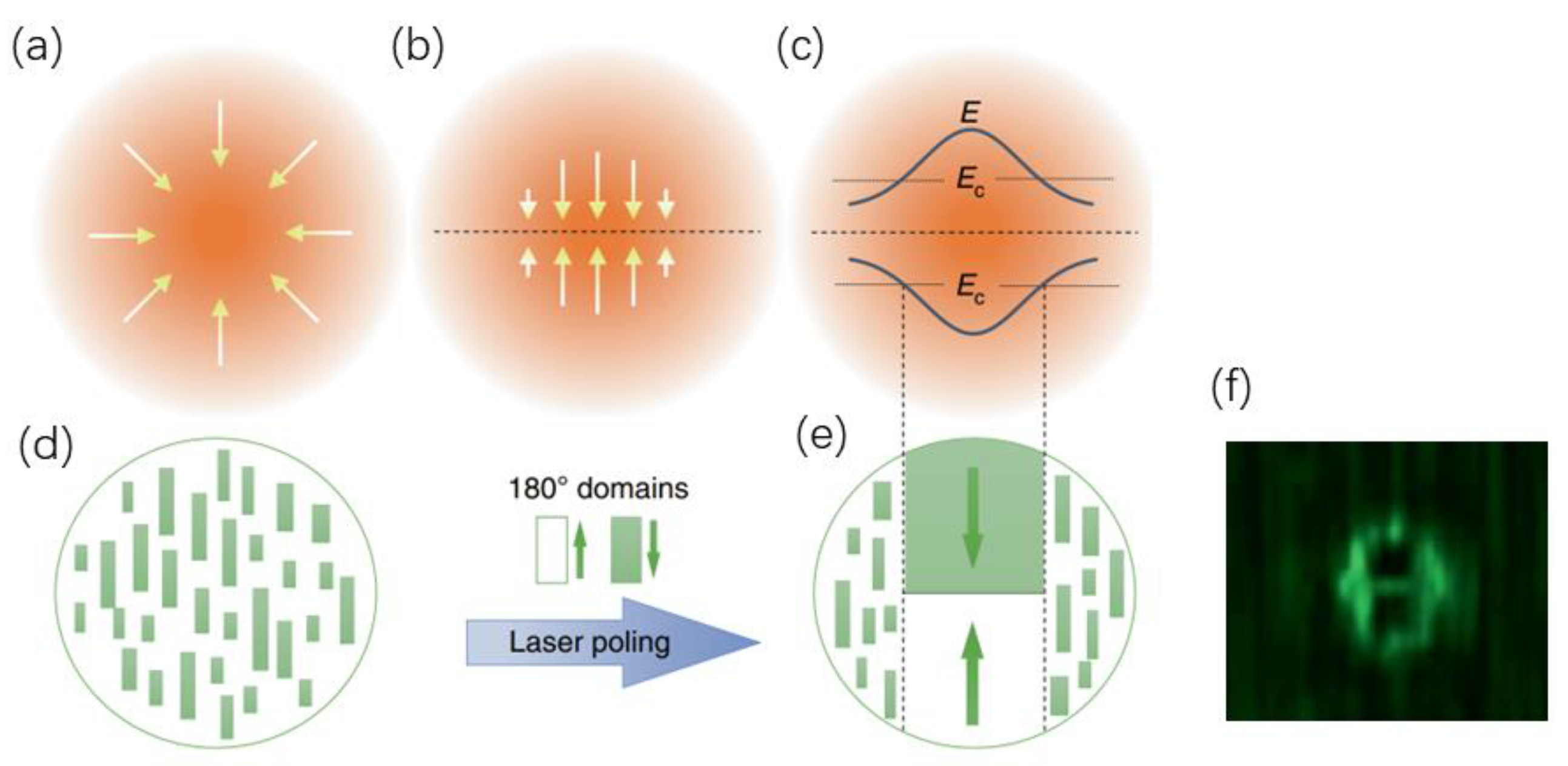
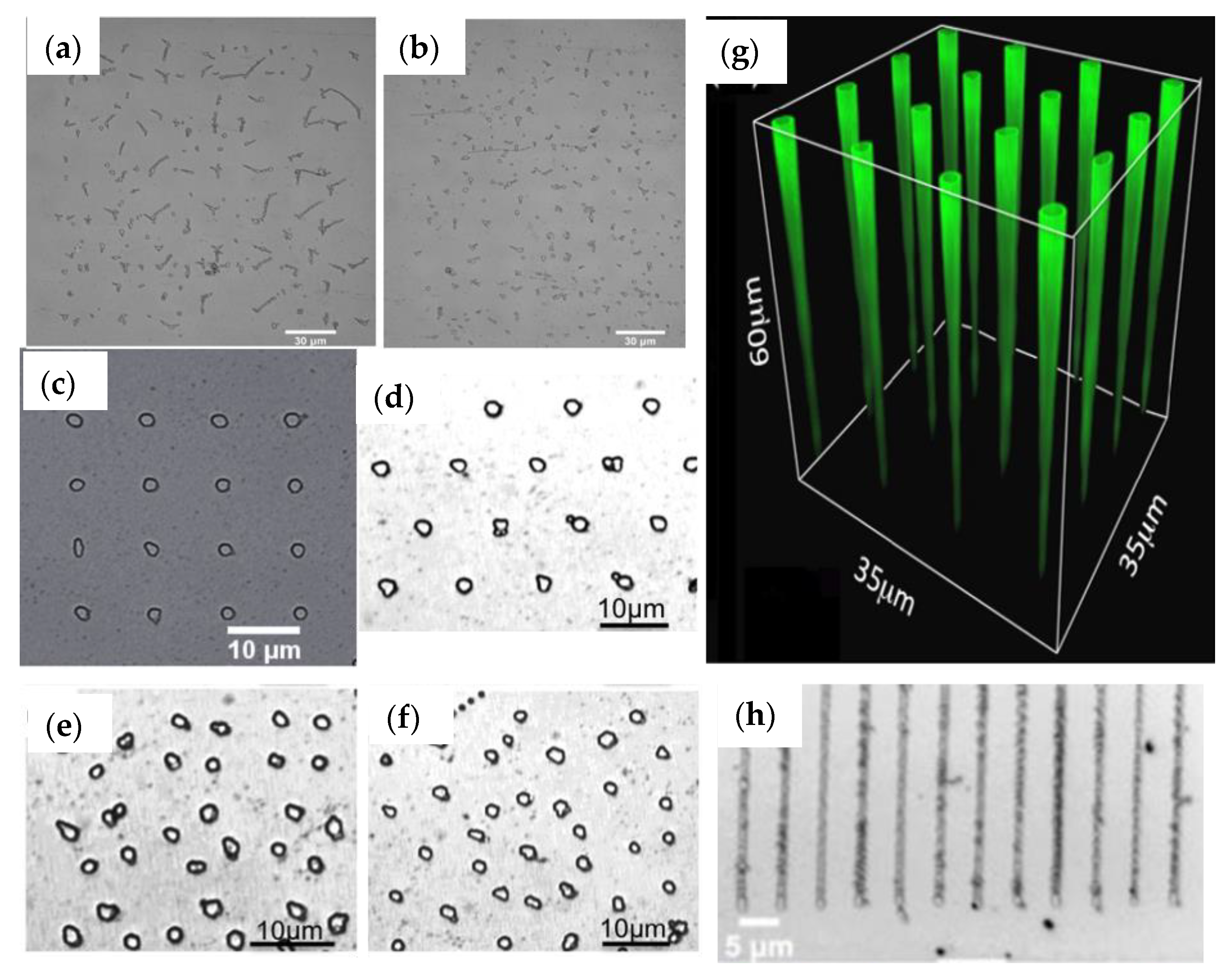
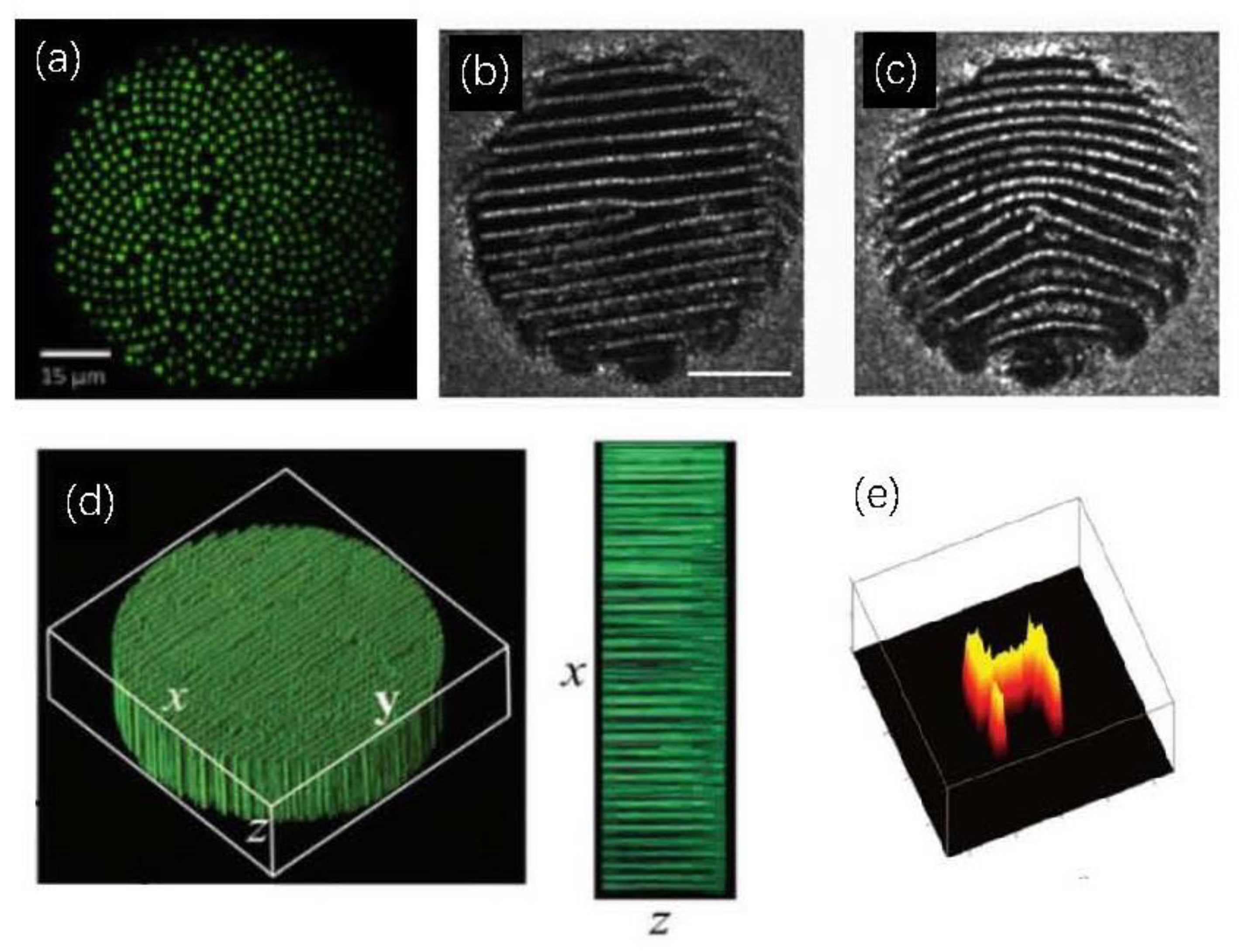
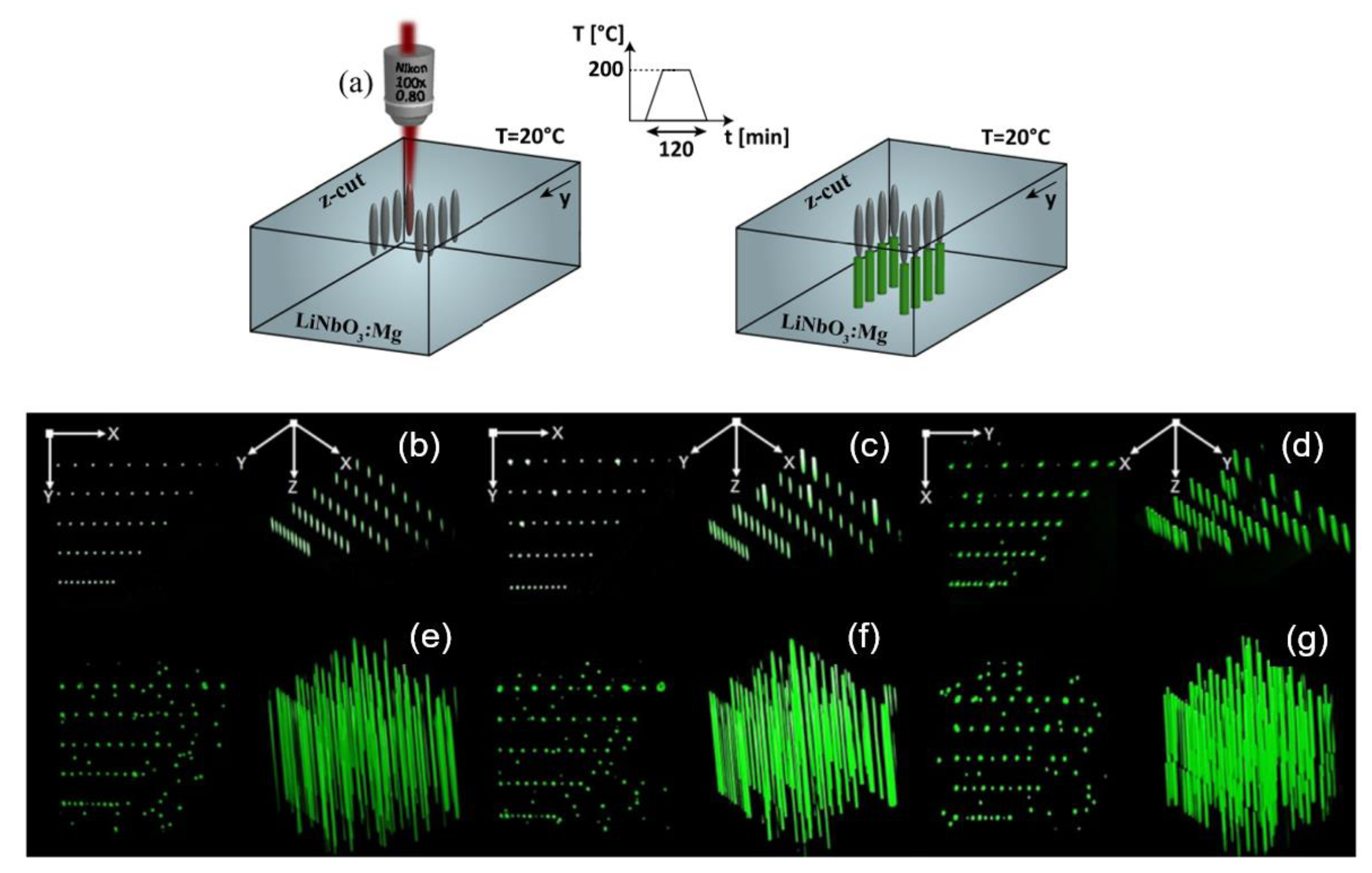
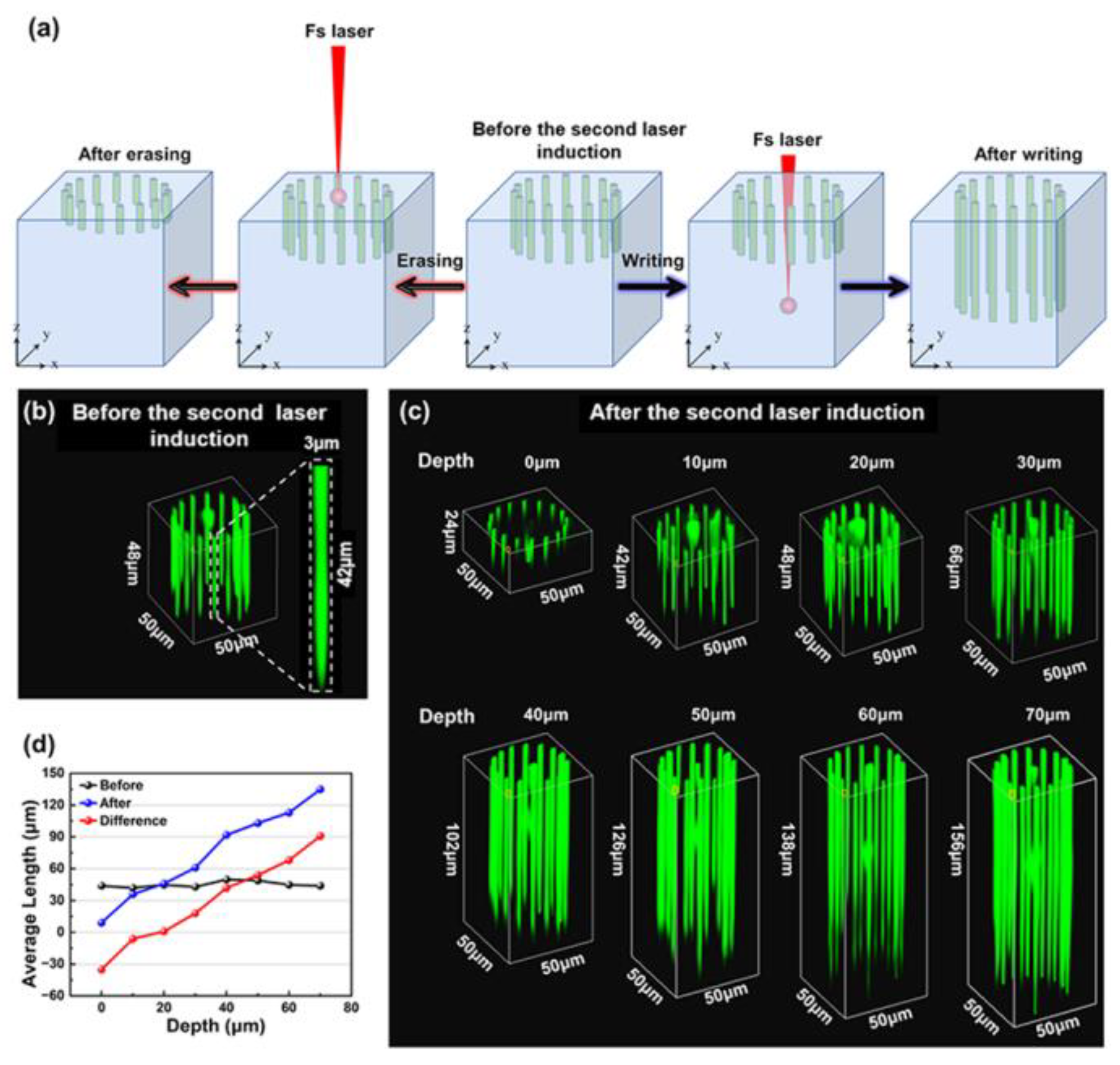

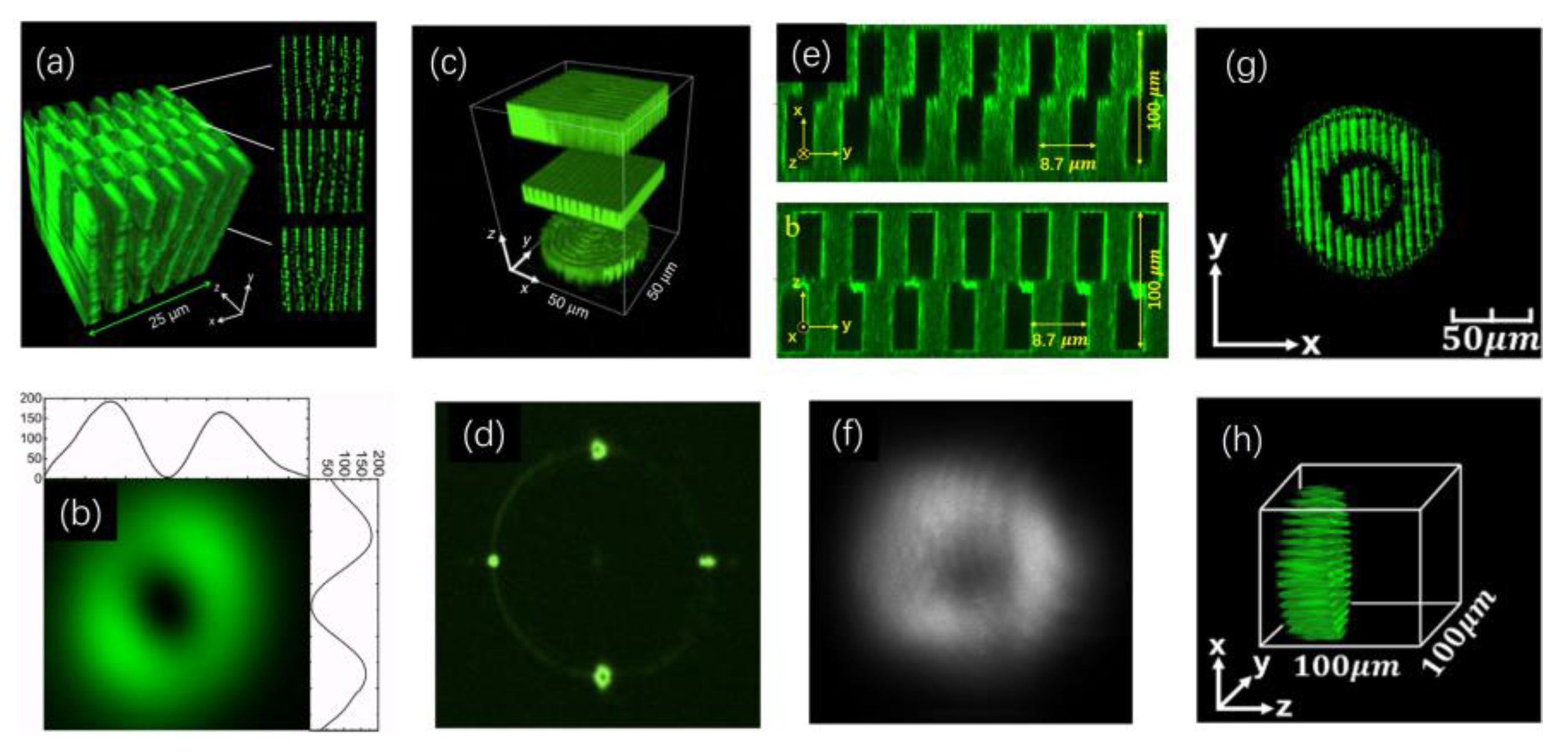
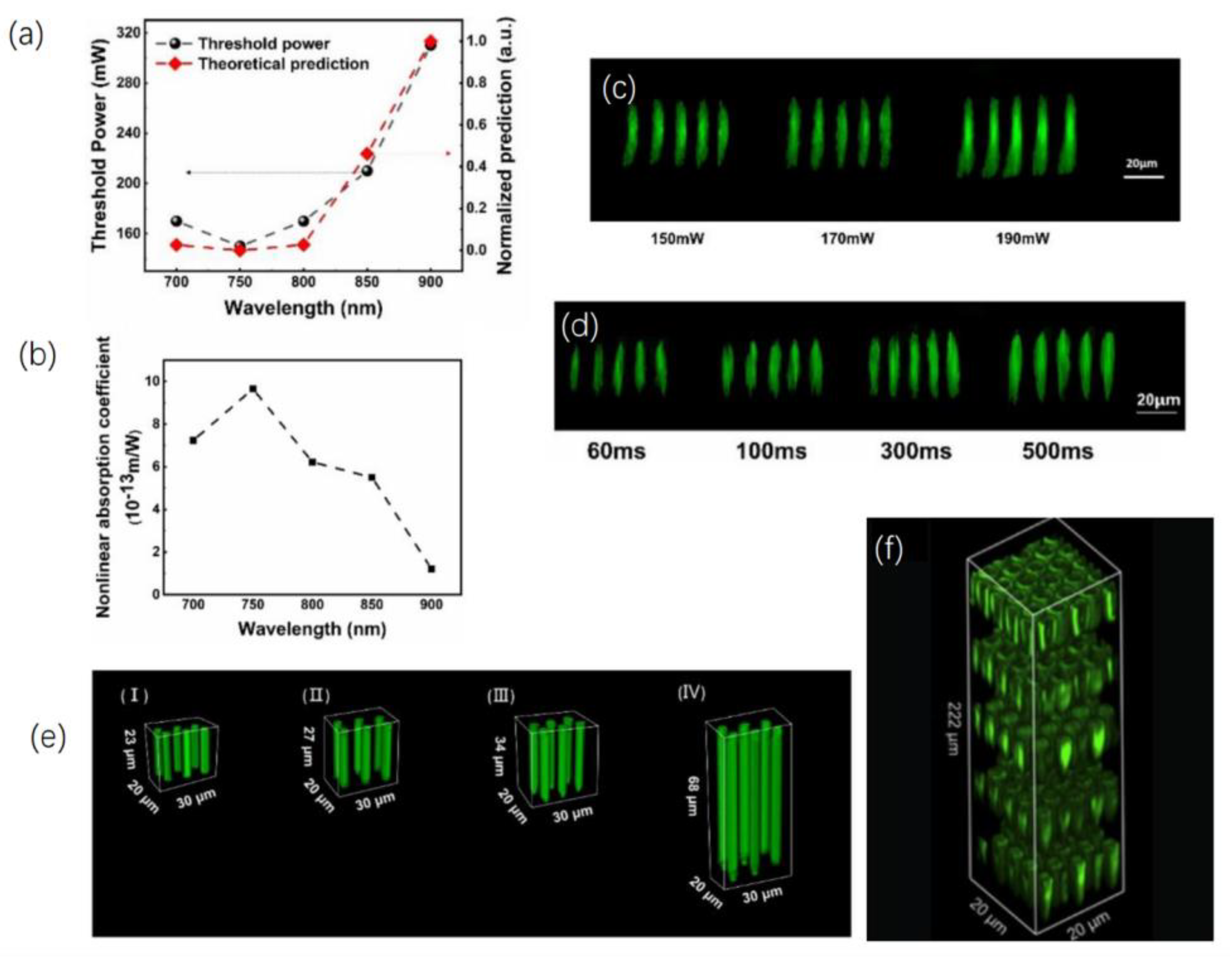
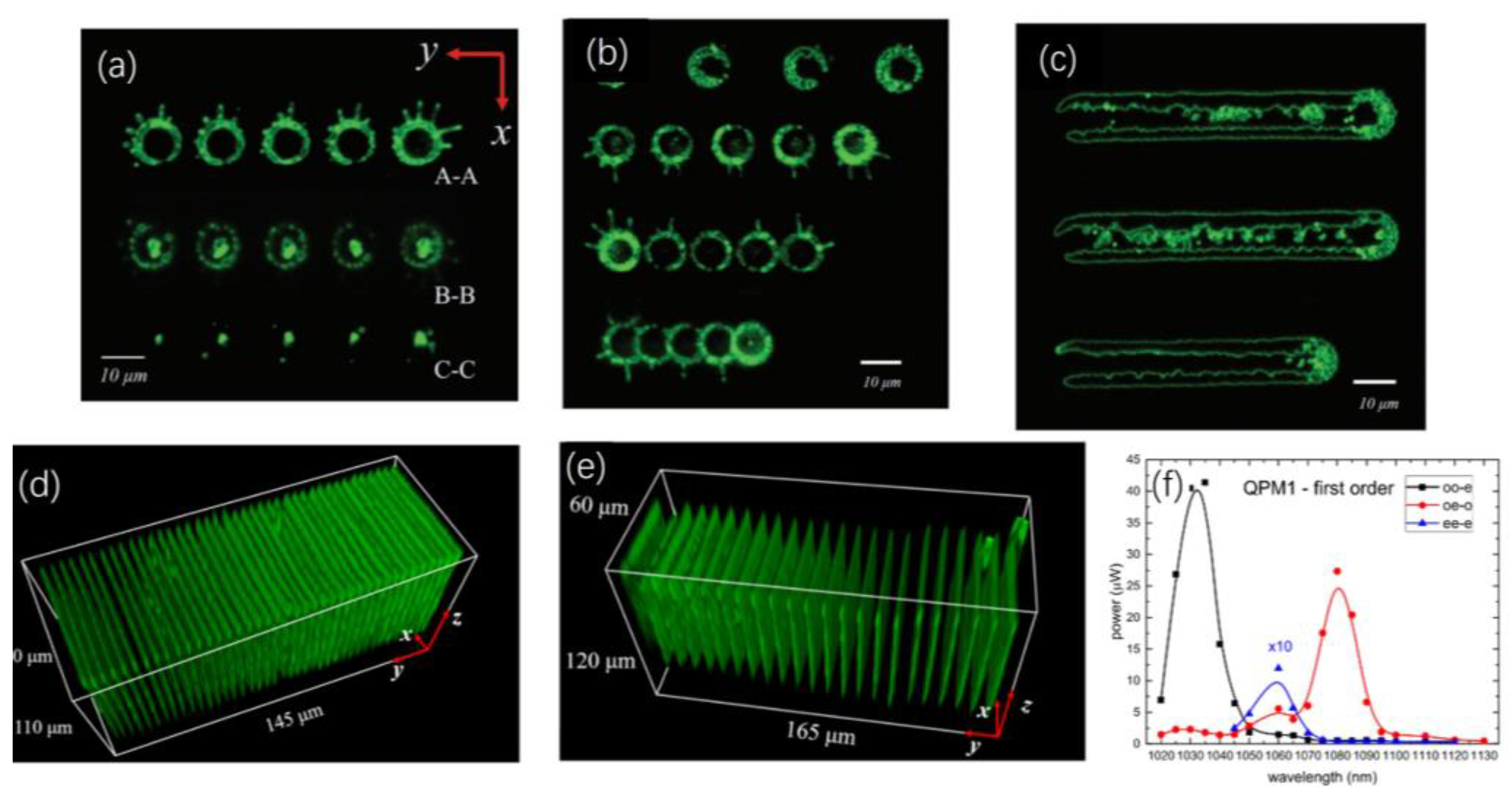
| Methods | High Resolution | Non-Destructive | 3D Visualization |
|---|---|---|---|
| Chemical etching | Yes | No | No |
| Piezo-response force microscopy (PFM) | Yes | No | No |
| Cherenkov second harmonic microscopy | Yes | Yes | Yes |
Disclaimer/Publisher’s Note: The statements, opinions and data contained in all publications are solely those of the individual author(s) and contributor(s) and not of MDPI and/or the editor(s). MDPI and/or the editor(s) disclaim responsibility for any injury to people or property resulting from any ideas, methods, instructions or products referred to in the content. |
© 2024 by the authors. Licensee MDPI, Basel, Switzerland. This article is an open access article distributed under the terms and conditions of the Creative Commons Attribution (CC BY) license (https://creativecommons.org/licenses/by/4.0/).
Share and Cite
Sheng, Y.; Chen, X.; Xu, T.; Liu, S.; Zhao, R.; Krolikowski, W. Research Progress on Femtosecond Laser Poling of Ferroelectrics. Photonics 2024, 11, 447. https://doi.org/10.3390/photonics11050447
Sheng Y, Chen X, Xu T, Liu S, Zhao R, Krolikowski W. Research Progress on Femtosecond Laser Poling of Ferroelectrics. Photonics. 2024; 11(5):447. https://doi.org/10.3390/photonics11050447
Chicago/Turabian StyleSheng, Yan, Xin Chen, Tianxiang Xu, Shan Liu, Ruwei Zhao, and Wieslaw Krolikowski. 2024. "Research Progress on Femtosecond Laser Poling of Ferroelectrics" Photonics 11, no. 5: 447. https://doi.org/10.3390/photonics11050447
APA StyleSheng, Y., Chen, X., Xu, T., Liu, S., Zhao, R., & Krolikowski, W. (2024). Research Progress on Femtosecond Laser Poling of Ferroelectrics. Photonics, 11(5), 447. https://doi.org/10.3390/photonics11050447





